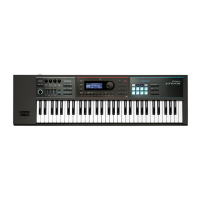18
Patch Mode
Eects Parameters
MFX
Parameter Value/Explanation
MFX Type
Turns MFX on/o, and species the type of MFX that is used. If MFX is on,
8
shows a “
(
” mark.
* For details on MFX, refer to “MFX Parameters (MFX, MFX1–3)” (p. 40).
00: THRU–80: BIT CRUSHER
Parameters for
each MFX type
Edit the parameters of the MFX type you’ve selected.
* Refer to “MFX Parameters (MFX, MFX1–3)” (p. 40).
Output Level
Adjusts the volume of the sound that has passed through the MFX.
If you’re applying a MFX, this species the depth of the MFX. If you’re not
applying a MFX, this species the volume of the original sound.
0–127
Chorus Send Level
Species the level of the signal sent to the chorus.
0–127
Reverb Send Level
Species the level of the signal sent to the reverb.
0–127
MFX control
If you wanted to change the volume of MFX sounds, the delay time of Delay, and
the like, using an external MIDI device, you would need to send System Exclusive
messages-MIDI messages designed exclusively for the JUNO-DS. However, System
Exclusive messages tend to be complicated, and the amount of data that needs to
be transmitted can get quite large.
For that reason, a number of the more typical of the JUNO-DS’s MFX parameters
have been designed so they accept the use of Control Change (or other) MIDI
messages for the purpose of making changes in their values. For example, you can
use the Pitch Bend lever to change the amount of distortion, or use the keyboard’s
touch to change the delay time of Delay.
The parameters that can be changed are predetermined for each type of MFX;
among the parameters described in “MFX parameters” (p. 40), these are indicated
by a “#.”
The function that allows you use MIDI messages to make these changes in realtime
to the MFX parameters is called the MFX control. Up to four MFX controls can be
used in a single patch/drum kit/performance.
When the MFX control is used, you can select the amount of control (Sens) applied,
the parameter selected (Destination), and the MIDI message used (Source).
MEMO
By using the Matrix control instead of the MFX control, you can also change the
parameters of some popular MFX in realtime (p. 12).
MFX CTRL
Parameter Value/Explanation
Source 1–4
Sets the MIDI message used to change the MFX parameter with the MFX
control.
OFF MFX control will not be used.
CC01–31, 33–95 Controller numbers 1–31, 33–95
PITCH BEND Pitch bend
AFTERTOUCH Aftertouch
SYS CTRL1–4 Use the System Control 1–4 Source setting (p. 34).
Destination 1–4
Sets the MFX parameters to be controlled with the Source 1–4. The MFX
parameters available for control will depend on the MFX Type.
* Refer to “MFX Parameters (MFX, MFX1–3)” (p. 40).
Sens 1–4
Species the depth of MFX control.
Specify a positive (+) value if you want to change the value of the assigned
destination in a positive direction (larger, toward the right, faster, etc.), or
specify a negative value (-) if you want to change the value in a negative
direction (smaller, toward the left, slower, etc.).
Larger values will allow a greater amount of control.
-63–+63
CHORUS
Parameter Value/Explanation
Chorus Type
Turns Chorus on/o, and species the type of chorus that is used. If Chorus
is on,
8
shows a “
(
” mark.
00: OFF Neither chorus or delay is used.
01: CHORUS Chorus is used.
02: DELAY Delay is used.
03: GM2 CHORUS GM2 chorus
Parameters for
each chorus type
Set the parameters of the selected chorus type.
* Refer to “Chorus Parameters” (p. 58).
Output Select
Species how the sound routed through chorus will be output.
MAIN Output to the OUTPUT jacks in stereo.
REV Output to reverb in mono.
M+R
Output to the OUTPUT jacks in stereo, and to
reverb in mono.
Chorus Level
Adjusts the volume of the sound that has passed through chorus.
0–127
REVERB
Parameter Value/Explanation
Reverb Type
Turns Reverb on/o, and species the type of reverb that is used. If Reverb
is on,
8
shows a “
(
” mark.
00: OFF Reverb is not used.
01: REVERB Normal reverb
02: SRV ROOM
This reverb simulates typical room acoustic
reections.
03: SRV HALL
This reverb simulates typical concert hall acoustic
reections.
04: SRV PLATE
This reverb simulates a reverb plate, a popular
type of articial reverb unit that derives its sound
from the vibration of a metallic plate.
05: GM2 REVERB GM2 reverb
Parameters for
each reverb type
Set the parameters of the selected reverb type.
* Refer to “Reverb Parameters” (p. 58).
Reverb Level
Adjusts the volume of the sound that has passed through reverb.
0–127

